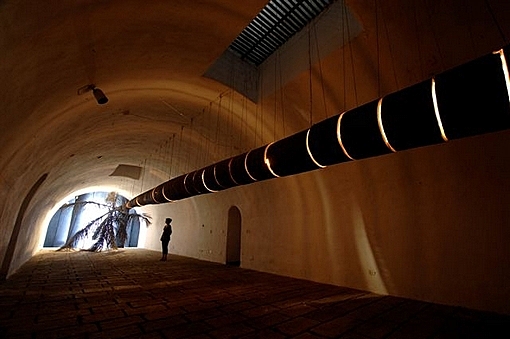Wifredo Lam Contemporary Art Center ,
May 11, 2012 - Jun 11, 2012
La Habana Vieja, Cuba
11th Havana Biennial
by Magaly Espinosa
My interest in those creations lies in the room they provide for thinking about an art whose formal and political values fosters dialogue from the fringes of the local within the current conditions that govern cultural exchange and representational politics. The challenge of the Biennial does not only lie in the works of art, but also in the institution that represents them and the critical reflection on which it is based.
A Biennial addressing non-Western contexts does not have to compete in the field of artistic skill, which can be appreciated ad nauseam in international events. With this I am not placing value on the precarity of form on which our artists often focus: on the contrary, I am calling attention to "festive art" as the major danger that appeared to dominate these practices, as such art does not lay down trends or create paradigms, it merely commercializes it, with the revelry that characterizes the jubilation generated by the market.
Bearing in mind those circumstances, the central exhibitions failed to make full use of the possibilities offered by the Biennial’s theme to pave the way for the cultural and social dialogues that identify our local and regional context. To this we should add the weight of Cuban art, which overshadowed the foreign exhibits located in spaces that were not well conceived curatorially, and the theoretical arm of the event, which took the form of conferences that failed to spark interesting debates. Nevertheless, we should highlight the conference given by Dr. Llilian Llanes, based on her book "Memorias. Bienal de La Habana 1988-1999", dealing with her experiences as the director of several editions of the Biennial.
I am in favor of maintaining the Biennial, given the opportunity it provides to view and reflect on art processes, but it should focus on the field of art rather than the outside factors that distort it. Although this point of view may be rather utopian, one thing for sure is that it’s really not worth repeating the experience of this biennial’s edition, which left one with the impression that the most important thing is to create art that follows the dictates of the market.
The sensation left behind confirms the value of art criticism when it is prepared to go out on a limb by exploring the difficult areas of the art world. In terms of art itself, it makes little sense to waste thinkers’ and artists’ time on a weak, indulgent, comfortable discourse that seeks to please everyone.
Notes:
* "I sometimes think it was my generation’s fate to live under the sign of that wise Asian curse that says: "may you live in interesting times"…" In: Llilian Llanes: Memorias de la Sexta Bienal de La Habana. Rev. Arte Cubano. No 1/1998, p. 36.
(1) Mosquera, Gerardo. "Caminar con el diablo. Textos sobre arte, internacionalización y culturas" Publicaciones EXIT, Spain, 2010, p. 151.
(2) See: Jorge Fernández Torres: Prácticas artísticas e imaginarios sociales. In: Catálogo de la XI Bienal de La Habana. Ed. Centro de Arte Contemporáneo Wifredo Lam / CNAP.2012, pages 16-28.
(3) For an idea as to how this edition of the Biennial grew numerically in relation to previous ones, at the Ninth Biennial for example, there were some 57 collateral exhibitions.
(4) I quote Elvia Rosa Castro, one of the most active experts on current Cuban art, at the presentation of her exhibition Escapando con el paisaje: "… In the context of the Havana Biennial, transformed years ago into a commercial platform whose feverishness surpasses the artistic and cultural interest that originated the event…".
(5) Javier G. Vilaltella. In an exchange of opinions with the author, specialist on Cultural Studies and professor at Munich University.
(6) Marilyn Zaitlyn. Arte cubano entre dos bienales. En: Rev. Arte Cubano. No 1/2001, p. 9.
(7) Antonio Eligio Tonel, art critic and curator who lives in Canada. One of the soundest critical voices to have studied and written on the so-called New Cuban Art.
(8) Made up of: Gabriela García, Néstor Álvarez, Héctor Remedio, Yadier González, Pável Méndez, Nelson Ladicani, Jaime S. Rodríguez and Cristian Cuevas, first-year students at the Instituto Superior de Arte de La Habana.
|







